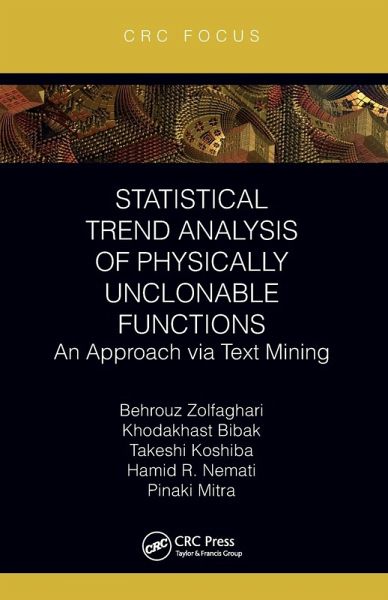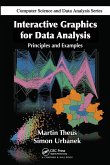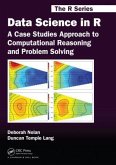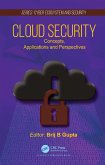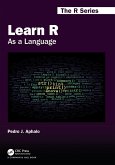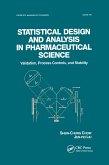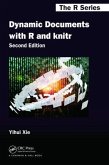Behrouz Zolfaghari, Khodakhast Bibak, Takeshi Koshiba, Hamid R Nemati, Pinaki Mitra
Statistical Trend Analysis of Physically Unclonable Functions
An Approach Via Text Mining
28,99 €
inkl. MwSt.
Versandfertig in über 4 Wochen

14 °P sammeln
Behrouz Zolfaghari, Khodakhast Bibak, Takeshi Koshiba, Hamid R Nemati, Pinaki Mitra
Statistical Trend Analysis of Physically Unclonable Functions
An Approach Via Text Mining
- Broschiertes Buch
- Merkliste
- Auf die Merkliste
- Bewerten Bewerten
- Teilen
- Produkt teilen
- Produkterinnerung
- Produkterinnerung
Statistical Trend Analysis of Physically Unclonable Functions first presents a review on cryptographic hardware and hardware-assisted cryptography. Afterwards, the authors present a combined survey and research work on PUFs using a systematic approach.
Andere Kunden interessierten sich auch für
![Interactive Graphics for Data Analysis Interactive Graphics for Data Analysis]() Martin TheusInteractive Graphics for Data Analysis86,99 €
Martin TheusInteractive Graphics for Data Analysis86,99 €![Data Science in R Data Science in R]() Deborah NolanData Science in R126,99 €
Deborah NolanData Science in R126,99 €![Cloud Security Cloud Security]() Cloud Security91,99 €
Cloud Security91,99 €![Learn R Learn R]() Pedro J AphaloLearn R86,99 €
Pedro J AphaloLearn R86,99 €![Statistical Modelling with Quantile Functions Statistical Modelling with Quantile Functions]() Warren GilchristStatistical Modelling with Quantile Functions91,99 €
Warren GilchristStatistical Modelling with Quantile Functions91,99 €![Statistical Design and Analysis in Pharmaceutical Science Statistical Design and Analysis in Pharmaceutical Science]() Shein-Chung ChowStatistical Design and Analysis in Pharmaceutical Science97,99 €
Shein-Chung ChowStatistical Design and Analysis in Pharmaceutical Science97,99 €![Dynamic Documents with R and knitr Dynamic Documents with R and knitr]() Yihui XieDynamic Documents with R and knitr107,99 €
Yihui XieDynamic Documents with R and knitr107,99 €-
-
-
Statistical Trend Analysis of Physically Unclonable Functions first presents a review on cryptographic hardware and hardware-assisted cryptography. Afterwards, the authors present a combined survey and research work on PUFs using a systematic approach.
Hinweis: Dieser Artikel kann nur an eine deutsche Lieferadresse ausgeliefert werden.
Hinweis: Dieser Artikel kann nur an eine deutsche Lieferadresse ausgeliefert werden.
Produktdetails
- Produktdetails
- Verlag: CRC Press
- Seitenzahl: 160
- Erscheinungstermin: 8. Oktober 2024
- Englisch
- Abmessung: 216mm x 140mm x 9mm
- Gewicht: 195g
- ISBN-13: 9780367764791
- ISBN-10: 0367764792
- Artikelnr.: 71583366
- Herstellerkennzeichnung
- Libri GmbH
- Europaallee 1
- 36244 Bad Hersfeld
- gpsr@libri.de
- Verlag: CRC Press
- Seitenzahl: 160
- Erscheinungstermin: 8. Oktober 2024
- Englisch
- Abmessung: 216mm x 140mm x 9mm
- Gewicht: 195g
- ISBN-13: 9780367764791
- ISBN-10: 0367764792
- Artikelnr.: 71583366
- Herstellerkennzeichnung
- Libri GmbH
- Europaallee 1
- 36244 Bad Hersfeld
- gpsr@libri.de
Behrouz Zolfaghari is currently a postdoctoral fellow at Indian Institute of Technology Guwahati. His research interests include hardware-oriented cryptography, information-theoretic cryptography, information theory, VLSI design and discrete mathematics. Khodakhast Bibak is an Assistant Professor at the Department of Computer Science and Software Engineering at Miami University. Previously, he was a Postdoctoral Research Associate (September 2017 - August 2018) in the Coordinated Science Laboratory at the University of Illinois at Urbana-Champaign. Before this, Khodakhast was a Postdoctoral Research Fellow (May-August 2017) at the Department of Computer Science, University of Victoria, from where he also received his PhD (April 2017). He earned a Master of Mathematics degree (April 2013) at the Department of Combinatorics and Optimization, University of Waterloo, where he was also a member of the Centre for Applied Cryptographic Research (CACR). Khodakhast's research interests are Cybersecurity, Applied Cryptography, Information Theory, Communications, Quantum Information Science (QIS), and related areas. Takeshi Koshiba received the PhD degree from Tokyo Institute of Technology. He is a full professor at the Department of Mathematics, the Faculty of Education and Integrated Arts and Sciences, Waseda University, Japan. His interests include theoretical and applied cryptography, the randomness in algorithms, and quantum computing and cryptography. Hamid R. Nemati is a full Professor of Information Systems at the University of North Carolina at Greensboro. He received his PhD from the University of Georgia in Information Technology and Management Science and his MBA from The University of Massachusetts. He is internationally recognized for his research in various aspects of Information Technology, including data analytics, big data, information security and privacy, organizational and behavioral aspects of Information Technology development and use. He has extensive professional experience as a developer, an analyst and project leader and has been a consultant for numerous major corporations. He has published nine books and over 120 peer reviewed academic publications in various premier scholarly and professional journals and conference proceedings. Pinaki Mitra is currently an associate professor at Department of Computer Science & Engineering, IIT Guwahati. He obtained his B. Tech in Computer Science and Engineering from Jadavpur University, Kolkata in 1987, India and his M. Tech in Computer Science and Engineering from Indian Institute of Science Bangalore, India in 1989. Finally, he obtained his Ph. D from Simon Fraser University, Canada in 1994. He worked on a project at Jadavpur University, department of Computer Science and Engineering. Subsequently he joined National Institute of Management, Kolkata, and served as an assistant professor. He joined IIT Guwahati in December, 2004. His research interest includes Cryptography, Network Security, Computer Graphics, Multimedia and Machine Learning.
Introduction
Cryptographic Hardware and Hardware-Assisted Cryptography
2.1 Existing Surveys
2.2 Design
2.2.1 Cryptographic Primitives
2.2.2 Cryptographic Hardware
2.2.3 Hardware-Assisted Ciphers
2.2.4 Automatic Design and Synthesis
2.2.5 Design Objectives
2.3 Implementation
2.3.1 Prototyping
2.3.2 Implementation Technologies
2.3.3 Implementation Goals and Challenges
2.4 Evaluation
2.4.1 Security Evaluation
2.4.2 Simulation and Performance Benchmarking
PUFs in Industry, Education Programs, and Books
3.1 Historical Background
3.2 PUF in Industry
3.3 PUF in Education Programs
3.4 PUF in Books
Preliminary Discussions
4.1 Related Works: A Survey on Surveys
4.2 Motivations
4.3 Methodology
4.4 Work Space
The classification Tree and Popularities
5.1 First Level Classification and Life Cycle
5.2 Design
5.2.1 Modeling
5.2.2 Design Objectives
5.2.3 Component Design
5.2.4 Post-Process, Expansion, Standardization and Alternatives
5.3 Implementation
5.4 Operation
5.4.1 Ecosystem
5.4.2 Interfaces
5.5 Evaluation and Production
Trend Analysis
6.1 Top Topics
6.1.1 The Most Popular Topics during the History
6.1.2 The Most Popular Topics in Top Conferences
6.1.3 Popular Topics in Top Journals
6.1.4 Popular Topics in Recent Years
6.2 Evolution Study
Future Roadmap
7.1 Trends
7.2 Conclusions and Further Works
References
Index
Cryptographic Hardware and Hardware-Assisted Cryptography
2.1 Existing Surveys
2.2 Design
2.2.1 Cryptographic Primitives
2.2.2 Cryptographic Hardware
2.2.3 Hardware-Assisted Ciphers
2.2.4 Automatic Design and Synthesis
2.2.5 Design Objectives
2.3 Implementation
2.3.1 Prototyping
2.3.2 Implementation Technologies
2.3.3 Implementation Goals and Challenges
2.4 Evaluation
2.4.1 Security Evaluation
2.4.2 Simulation and Performance Benchmarking
PUFs in Industry, Education Programs, and Books
3.1 Historical Background
3.2 PUF in Industry
3.3 PUF in Education Programs
3.4 PUF in Books
Preliminary Discussions
4.1 Related Works: A Survey on Surveys
4.2 Motivations
4.3 Methodology
4.4 Work Space
The classification Tree and Popularities
5.1 First Level Classification and Life Cycle
5.2 Design
5.2.1 Modeling
5.2.2 Design Objectives
5.2.3 Component Design
5.2.4 Post-Process, Expansion, Standardization and Alternatives
5.3 Implementation
5.4 Operation
5.4.1 Ecosystem
5.4.2 Interfaces
5.5 Evaluation and Production
Trend Analysis
6.1 Top Topics
6.1.1 The Most Popular Topics during the History
6.1.2 The Most Popular Topics in Top Conferences
6.1.3 Popular Topics in Top Journals
6.1.4 Popular Topics in Recent Years
6.2 Evolution Study
Future Roadmap
7.1 Trends
7.2 Conclusions and Further Works
References
Index
Introduction
Cryptographic Hardware and Hardware-Assisted Cryptography
2.1 Existing Surveys
2.2 Design
2.2.1 Cryptographic Primitives
2.2.2 Cryptographic Hardware
2.2.3 Hardware-Assisted Ciphers
2.2.4 Automatic Design and Synthesis
2.2.5 Design Objectives
2.3 Implementation
2.3.1 Prototyping
2.3.2 Implementation Technologies
2.3.3 Implementation Goals and Challenges
2.4 Evaluation
2.4.1 Security Evaluation
2.4.2 Simulation and Performance Benchmarking
PUFs in Industry, Education Programs, and Books
3.1 Historical Background
3.2 PUF in Industry
3.3 PUF in Education Programs
3.4 PUF in Books
Preliminary Discussions
4.1 Related Works: A Survey on Surveys
4.2 Motivations
4.3 Methodology
4.4 Work Space
The classification Tree and Popularities
5.1 First Level Classification and Life Cycle
5.2 Design
5.2.1 Modeling
5.2.2 Design Objectives
5.2.3 Component Design
5.2.4 Post-Process, Expansion, Standardization and Alternatives
5.3 Implementation
5.4 Operation
5.4.1 Ecosystem
5.4.2 Interfaces
5.5 Evaluation and Production
Trend Analysis
6.1 Top Topics
6.1.1 The Most Popular Topics during the History
6.1.2 The Most Popular Topics in Top Conferences
6.1.3 Popular Topics in Top Journals
6.1.4 Popular Topics in Recent Years
6.2 Evolution Study
Future Roadmap
7.1 Trends
7.2 Conclusions and Further Works
References
Index
Cryptographic Hardware and Hardware-Assisted Cryptography
2.1 Existing Surveys
2.2 Design
2.2.1 Cryptographic Primitives
2.2.2 Cryptographic Hardware
2.2.3 Hardware-Assisted Ciphers
2.2.4 Automatic Design and Synthesis
2.2.5 Design Objectives
2.3 Implementation
2.3.1 Prototyping
2.3.2 Implementation Technologies
2.3.3 Implementation Goals and Challenges
2.4 Evaluation
2.4.1 Security Evaluation
2.4.2 Simulation and Performance Benchmarking
PUFs in Industry, Education Programs, and Books
3.1 Historical Background
3.2 PUF in Industry
3.3 PUF in Education Programs
3.4 PUF in Books
Preliminary Discussions
4.1 Related Works: A Survey on Surveys
4.2 Motivations
4.3 Methodology
4.4 Work Space
The classification Tree and Popularities
5.1 First Level Classification and Life Cycle
5.2 Design
5.2.1 Modeling
5.2.2 Design Objectives
5.2.3 Component Design
5.2.4 Post-Process, Expansion, Standardization and Alternatives
5.3 Implementation
5.4 Operation
5.4.1 Ecosystem
5.4.2 Interfaces
5.5 Evaluation and Production
Trend Analysis
6.1 Top Topics
6.1.1 The Most Popular Topics during the History
6.1.2 The Most Popular Topics in Top Conferences
6.1.3 Popular Topics in Top Journals
6.1.4 Popular Topics in Recent Years
6.2 Evolution Study
Future Roadmap
7.1 Trends
7.2 Conclusions and Further Works
References
Index
